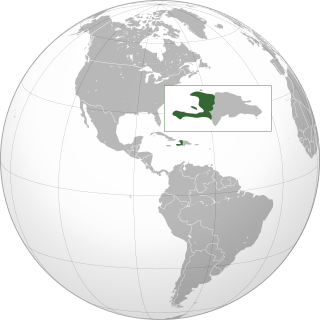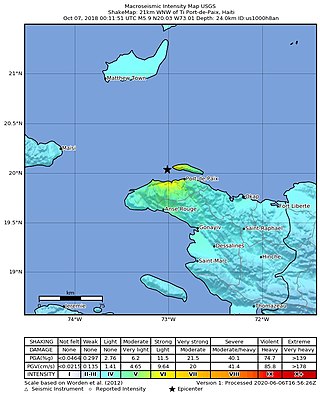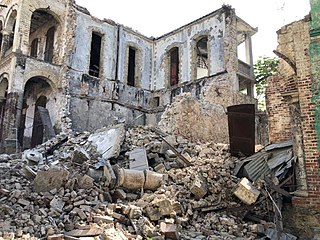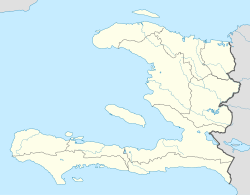
Haiti, officially the Republic of Haiti, and formerly known as Hayti, is a country located on the island of Hispaniola in the Greater Antilles archipelago of the Caribbean Sea, east of Cuba and Jamaica, and south of The Bahamas and the Turks and Caicos Islands. It occupies the western three-eighths of the island which it shares with the Dominican Republic. To its south-west lies the small Navassa Island, which is claimed by Haiti but is disputed as a United States territory under federal administration. Haiti is 27,750 km2 (10,714 sq mi) in size, the third largest country in the Caribbean by area, and has an estimated population of 11.4 million, making it the most populous country in the Caribbean. The capital is Port-au-Prince.

Jacmel is a commune in southern Haiti founded by the Spanish in 1504 and repopulated by the French in 1698. It is the capital of the department of Sud-Est, 24 miles southwest of Port-au-Prince across the Tiburon Peninsula, and has an estimated population of 40,000, while the commune of Jacmel had a population of 137,966 at the 2003 Census. The town's name is derived from its indigenous Taíno name of Yaquimel. In 1925, Jacmel was dubbed as the "City of Light," becoming the first in the Caribbean to have electricity.

Les Cayes, often referred to as Aux Cayes, is a commune and seaport in the Les Cayes Arrondissement, in the Sud department of Haiti, with a population of 71,236. Due to its isolation from the political turmoil of the capital, Port-au-Prince, it is one of Haiti's major ports, with export trade concentrating on mostly coffee and sugarcane. As the world's largest supplier of vetiver, it exports 250 tons annually of this ingredient of perfume and fragrance manufacturing. Minor exports include bananas and timber.

Léogâne is one of the coastal communes in Haiti. It is located in the eponymous Léogâne Arrondissement, which is part of the Ouest Department. The port town is located about 30 km (19 mi) west of the Haitian capital, Port-au-Prince. Léogâne has a rich and unique culture, especially with regard to the arts, music, literature, cuisine, and architecture. It also holds importance for archaeological and historical sites such as Fort Campan.

Lesbian, gay, bisexual, and transgender (LGBT) persons in Haiti face social and legal challenges not experienced by non-LGBT residents. Adult, noncommercial and consensual same-sex sexuality is not a criminal offense, but transgender people can be fined for violating a broadly written vagrancy law. Public opinion tends to be opposed to LGBT rights, which is why LGBT people are not protected from discrimination, are not included in hate crime laws, and households headed by same-sex couples do not have any of the legal rights given to married couples.

Pétion-Ville is a commune and a suburb of Port-au-Prince, Haiti, in the hills east and separate from the city itself on the northern hills of the Massif de la Selle. Founded in 1831 by president Jean-Pierre Boyer, it was named after Alexandre Sabès Pétion (1770–1818), the Haitian general and president later recognized as one of the country's four founding fathers.

The following is a summary of significant earthquakes during the 21st century. In terms of fatalities, the 2004 Indian Ocean earthquake was the most destructive event with around 227,898 fatalities, followed by the 2010 Haiti earthquake with about 160,000 fatalities, the 2008 Sichuan earthquake with 87,587 fatalities, the 2005 Kashmir earthquake with 87,351 fatalities, and the 2023 Turkey–Syria earthquake with at least 59,259 fatalities.

Jean Jimmy Alexandre, better known by his stage name Jimmy O, was a Haitian hip hop artist who was born in Port-au-Prince and lived in New York City. He was involved with Wyclef Jean's Yéle Haiti Foundation. Jimmy O performed his music in Haitian Creole.

The response to the 2010 Haiti earthquake included national governments, charitable and for-profit organizations from around the world which began coordinating humanitarian aid designed to help the Haitian people. Some countries arranged to send relief and rescue workers and humanitarian supplies directly to the earthquake damage zones, while others sought to organize national fund raising to provide monetary support for the nonprofit groups working directly in Haiti. OCHA coordinates and tracks this on a daily basis. The information is disseminated through the UN news and information portal, ReliefWeb. As of September 5, 2013, ReliefWeb have reported a total relief funding of $3.5 billion given.

A catastrophic magnitude 7.0 Mw earthquake struck Haiti at 16:53 local time on Tuesday, 12 January 2010. The epicenter was near the town of Léogâne, Ouest department, approximately 25 kilometres (16 mi) west of Port-au-Prince, Haiti's capital.

Casualties of the 2010 Haiti earthquake include both civilian and government officials, locals and foreigners – however the overwhelming majority of those killed and wounded in the quake were Haitian civilians. A number of public figures died in the earthquake, including government officials, clergy members, musicians, together with foreign civilian and military personnel working with the United Nations. On 15 January, the Red Cross estimated the death toll at between 45,000 and 50,000, however by 24 January, Communications Minister Marie-Laurence Jocelyn Lassegue said the death toll was over 150,000 in the Port-au-Prince metropolitan area alone. Haitian president René Préval reported on 27 January that "nearly 170,000" bodies had been counted.

The humanitarian response by national governments to the 2010 Haiti earthquake included numerous national governments from around the world pledging to send humanitarian aid to the Haitian people. The United Nations Office for the Coordination of Humanitarian Affairs (OCHA) and ReliefWeb are coordinating and tracking this aid.
The timeline of rescue efforts after the 2010 Haiti earthquake of 12 January 2010 involves the sequence of events in the days following a highly destructive 7.0 Mw earthquake with an epicenter 25 kilometres (16 mi) west of the nation's capital, Port-au-Prince. With at least 70% of the city's buildings destroyed, the earthquake also caused damage and loss of life in other parts of the country. The Haitian government experienced a near-collapse and affected people were left mostly to their own resources until foreign aid arrived in the following days. Initial death toll estimates ranged between 50,000 and 200,000.

The humanitarian responses by non-governmental organizations to the 2010 Haiti earthquake included many organisations, such as international, religious, and regionally based NGOs, which immediately pledged support in the aftermath of the 2010 Haiti earthquake. Besides a large multi-contingency contribution by national governments, NGOs contributed significantly to both on-the-ground rescue efforts and external solicitation of aid for the rescue efforts.
This article describes humanitarian responses from "for-profit" organizations, such as business corporations, following the January 12, 2010, earthquake in Haiti.
"Stranded (Haiti Mon Amour)" is a song recorded by Jay-Z, Bono, The Edge and Rihanna for Hope for Haiti Now, a live album by various artists to benefit the campaign of the same name to alleviate the 2010 Haiti earthquake. The song was written by Jay-Z, The Edge and Bono and produced by Swizz Beatz.

Damage to infrastructure in the 2010 Haiti earthquake was extensive and affected areas included Port-au-Prince, Petit-Goâve, Léogâne, Jacmel and other settlements in southwestern Haiti. In February Prime Minister Jean-Max Bellerive estimated that 250,000 residences and 30,000 commercial buildings had collapsed or were severely damaged. The deputy mayor of Léogâne, which was at the epicenter of the earthquake, reported that 90% percent of the buildings in that city had been destroyed and Léogâne had "to be totally rebuilt." Many notable landmark buildings were significantly damaged or destroyed, including the Presidential Palace, the National Assembly building, the Port-au-Prince Cathedral, and the main jail. The Ministry of Education estimated that half the nation's 15,000 primary schools and 1,500 secondary schools were severely damaged, cracked or destroyed. In addition, the three main universities in Port-au-Prince were also severely damaged. Other affected infrastructure included telephone networks, radio station, factories, and museums. Poor infrastructure before the earthquake only made the aftermath worse. It would take half a day to make a trip of a few miles. The roads would also crisscross haphazardly due to disorganized construction.

On October 6, 2018, at approximately 8:11 p.m, a magnitude 5.9 earthquake struck 19 kilometers northwest of Port-de-Paix, Haiti. The earthquake damaged structures and killed 18 people.

At 08:29:09 EDT on 14 August 2021, a magnitude 7.2 earthquake struck the Tiburon Peninsula in the Caribbean nation of Haiti. It had a 10-kilometre-deep (6.2 mi) hypocenter near Petit-Trou-de-Nippes, approximately 150 kilometres (93 mi) west of the capital, Port-au-Prince. Tsunami warnings were briefly issued for the Haitian coast. At least 2,248 people were confirmed killed as of 1 September 2021 and more than 12,200 injured, mostly in the Sud Department. An estimated 650,000 people were in need of assistance. At least 137,500 buildings were damaged or destroyed.
















